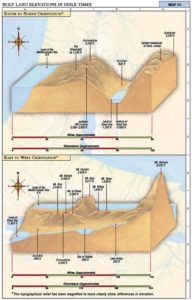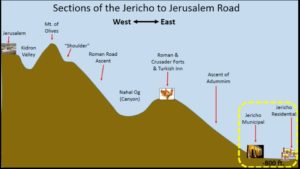In my course entitled, “The Land of the Bible,” developed for both the M.A. in Biblical Studies and the M.A. in Theological Studies, my students in the College and Adult Graduate Studies at Colorado University are asked to give me their understanding of the Land of Israel, at the beginning of the course. Most of them tell me it is arid, rocky, full of sand. Some think of the topography as flat. And others are convinced Israel is more of a second or third-world country. And then the fun begins with one “A-ha-moment” after another. So throughout the next number of weeks, I want to introduce you to the “REAL” Land of the Bible, so you have no question that both the Bible and Israel are about real people, in real locations, experiencing real events.
To understand the people and events of the Bible, we must begin by grasping a view of Israel’s topography. Israel is not flat, even though many Bible maps show it as flat. Some of the best Bible tools I’ve found that capture an understanding of the topography in the Land are Carl G. Rasmussen’s book, “Zondervan Atlas of the Bible,” published in 2010 and William Schlegel’s “Satellite Bible Atlas.” I’ve chosen to use some of their drawings, videos, and photos, so you recognize the Land of Israel as it is. First, let’s check out two cross-sections of Israel.

When you move from West to East, you move from sea-level up to Jerusalem at 2,600′, then down to the Dead Sea at 1,350′ below sea-level and finally back up to the Jordan Plateau at close to 3,000′ elevation. This dramatic elevation difference meant that Jerusalem held the “high-country” and was able to protect herself from invaders from the East and West, and South, but not from the North. In fact, Jerusalem surrounded itself with a wall in the southern end of the city, but three walls in the northern section.
When you look at the South to North elevations, the perspective changes dramatically. Here you move from sea-level to 9,000 feet elevation at Mount Hermon.
Now let’s apply two Biblical accounts to these topographical maps. Many of us are familiar with Jesus’ parable of the Good Samaritan. Though it is a parable or story, Jesus used it to communicate what a true “neighbor” is. But is there a “real” road from Jerusalem to Jericho? Was it hazardous due to both the ascent or descent in elevation and because robbers were familiar on that road? The answers to both questions are a definite yes. As you travel up and down that road, you move up the Ascent of Adummim. On the east side is the deep Wadi Qilt Canyon. I’ve traveled that road by bus, and it took about 30-45 minutes for the fifteen-mile journey, with hairpin curves and deep canyons. But in Jesus’ day, they traveled that road by donkey or on foot. From Jerusalem to Jericho you descend from 2,600’ elevation (Jerusalem) to -800’ elevation (Jericho), a 3,400 feet descent or ascent going from Jericho to Jerusalem.

However, this dangerous road is not only included in a parable but also is the very road Jesus traveled on numerous occasions.
In fact, it was the one our Lord ascended, after having dinner at the home of Zacchaeus, as the Lord was on His way to His journey to Jerusalem, an event we call His Triumphal Entry, when He rode into Jerusalem on a donkey, knowing it would be His last week on earth.
Imagine all of the thoughts that went through His mind as He climbed the steep Ascent of Adummim, then descended into the Canyon of Nahal Og, ascending once again on the Roman Ascent, to the Mt. of Olives, and then finally dropping into the Kidron Valley and up to Jerusalem. While the disciples were arguing among themselves who would be the greatest in the Kingdom, Jesus focused on fulfilling a plan of redemption for the entire world. That plan would cost Him His life, but provide salvation for all who would receive a gift only a loving Father would be willing to give to a wayward, rebellious child – a love-gift of forgiveness of sin, release from its penalty of eternal separation from God, and a guarantee of life eternal.
So the next time you hear the story of the Good Samaritan or think regarding Jesus’ triumphal entry into Jerusalem on Palm Sunday, keep in mind that the Jericho/Jerusalem road does exist today, and the Biblical events on this road are real.
